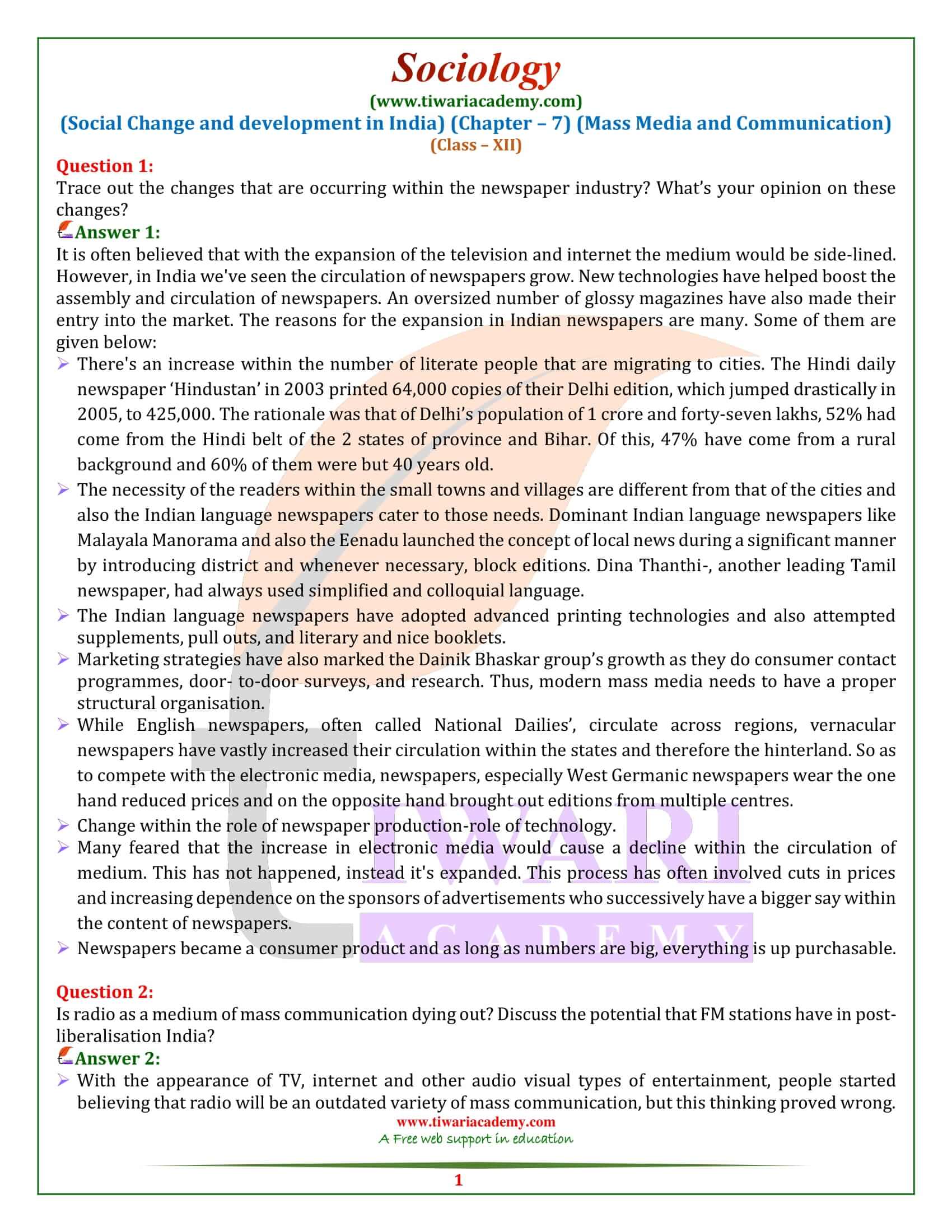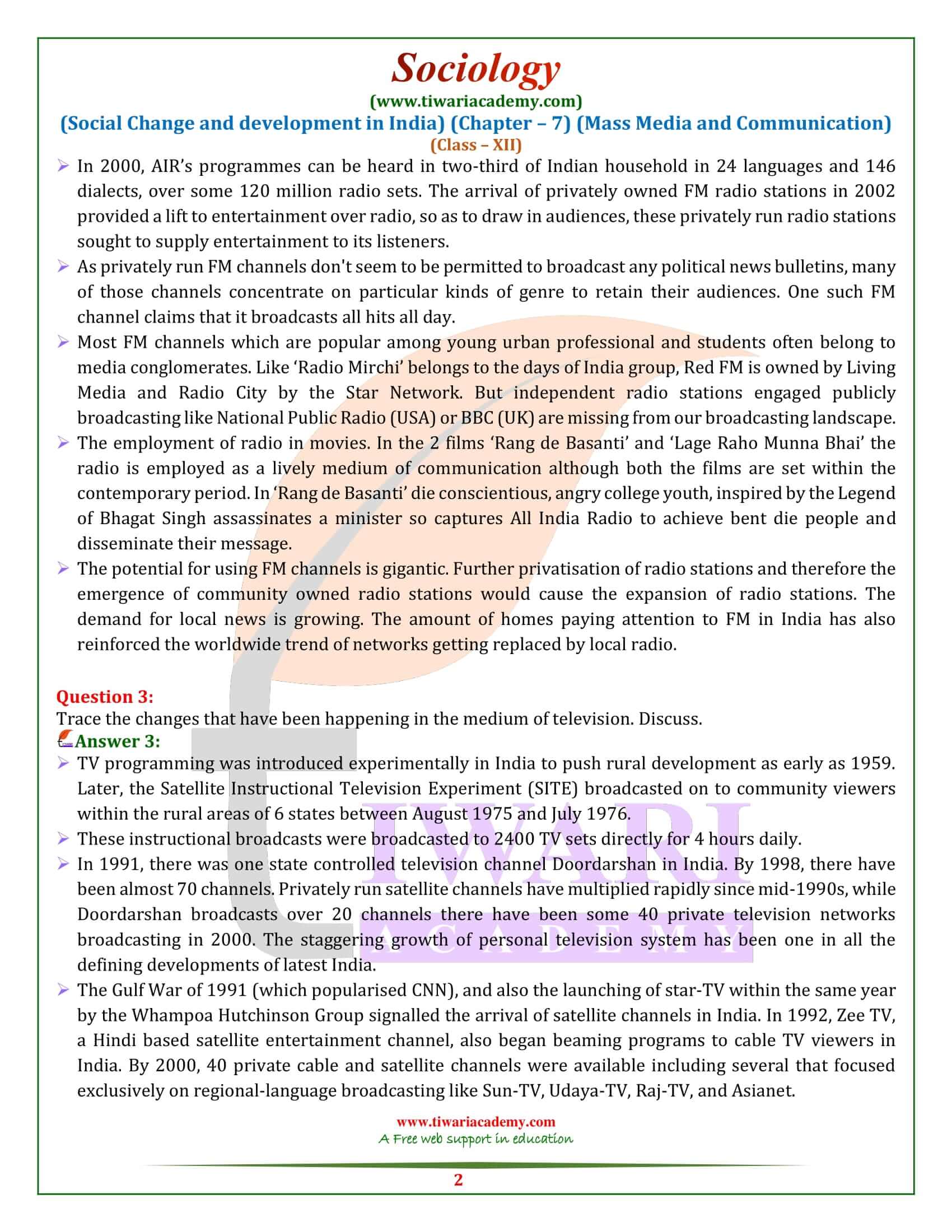NCERT Solutions for Class 12 Sociology Chapter 7 Mass Media and Communications question answers in English Medium updated for session 2024-25. Class 12 Sociology Chapter 7 Part 2 Social Change and Development in India extra questions and MCQ are also given with compete explanation.
Class 12 Sociology Chapter 7 Mass Media and Communications Question Answers
Trace out the changes that are occurring within the newspaper industry? What’s your opinion on these changes?
It is often believed that with the expansion of the television and internet the medium would be side-lined. However, in India we’ve seen the circulation of newspapers grow. New technologies have helped boost the assembly and circulation of newspapers. An oversized number of glossy magazines have also made their entry into the market. The reasons for the expansion in Indian newspapers are many. Some of them are given below:
There’s an increase within the number of literate people that are migrating to cities. The Hindi daily newspaper ‘Hindustan’ in 2003 printed 64,000 copies of their Delhi edition, which jumped drastically in 2005, to 425,000. The rationale was that of Delhi’s population of 1 crore and forty-seven lakhs, 52% had come from the Hindi belt of the 2 states of province and Bihar. Of this, 47% have come from a rural background and 60% of them were but 40 years old.
The necessity of the readers within the small towns and villages are different from that of the cities and also the Indian language newspapers cater to those needs. Dominant Indian language newspapers like Malayala Manorama and also the Eenadu launched the concept of local news during a significant manner by introducing district and whenever necessary, block editions. Dina Thanthi-, another leading Tamil newspaper, had always used simplified and colloquial language.
The Indian language newspapers have adopted advanced printing technologies and also attempted supplements, pull outs, and literary and nice booklets.
Marketing strategies have also marked the Dainik Bhaskar group’s growth as they do consumer contact programmes, door- to-door surveys, and research. Thus, modern mass media needs to have a proper structural organisation.
While English newspapers, often called National Dailies’, circulate across regions, vernacular newspapers have vastly increased their circulation within the states and therefore the hinterland. So as to compete with the electronic media, newspapers, especially West Germanic newspapers wear the one hand reduced prices and on the opposite hand brought out editions from multiple centres.
Change within the role of newspaper production-role of technology.
Many feared that the increase in electronic media would cause a decline within the circulation of medium. This has not happened, instead it’s expanded. This process has often involved cuts in prices and increasing dependence on the sponsors of advertisements who successively have a bigger say within the content of newspapers.
Newspapers became a consumer product and as long as numbers are big, everything is up purchasable.
Is radio as a medium of mass communication dying out? Discuss the potential that FM stations have in post-liberalisation India?
With the appearance of TV, internet and other audio visual types of entertainment, people started believing that radio will be an outdated variety of mass communication, but this thinking proved wrong.
In 2000, AIR’s programmes can be heard in two-third of Indian household in 24 languages and 146 dialects, over some 120 million radio sets. The arrival of privately owned FM radio stations in 2002 provided a lift to entertainment over radio, so as to draw in audiences, these privately run radio stations sought to supply entertainment to its listeners.
As privately run FM channels don’t seem to be permitted to broadcast any political news bulletins, many of those channels concentrate on particular kinds of genre to retain their audiences. One such FM channel claims that it broadcasts all hits all day.
Most FM channels which are popular among young urban professional and students often belong to media conglomerates. Like ‘Radio Mirchi’ belongs to the days of India group, Red FM is owned by Living Media and Radio City by the Star Network. But independent radio stations engaged publicly broadcasting like National Public Radio (USA) or BBC (UK) are missing from our broadcasting landscape.
The employment of radio in movies. In the 2 films ‘Rang de Basanti’ and ‘Lage Raho Munna Bhai’ the radio is employed as a lively medium of communication although both the films are set within the contemporary period. In ‘Rang de Basanti’ die conscientious, angry college youth, inspired by the Legend of Bhagat Singh assassinates a minister so captures All India Radio to achieve bent die people and disseminate their message.
The potential for using FM channels is gigantic. Further privatisation of radio stations and therefore the emergence of community owned radio stations would cause the expansion of radio stations. The demand for local news is growing. The amount of homes paying attention to FM in India has also reinforced the worldwide trend of networks getting replaced by local radio.
Trace the changes that have been happening in the medium of television. Discuss.
TV programming was introduced experimentally in India to push rural development as early as 1959. Later, the Satellite Instructional Television Experiment (SITE) broadcasted on to community viewers within the rural areas of 6 states between August 1975 and July 1976.
These instructional broadcasts were broadcasted to 2400 TV sets directly for 4 hours daily.
In 1991, there was one state controlled television channel Doordarshan in India. By 1998, there have been almost 70 channels. Privately run satellite channels have multiplied rapidly since mid-1990s, while Doordarshan broadcasts over 20 channels there have been some 40 private television networks broadcasting in 2000. The staggering growth of personal television system has been one in all the defining developments of latest India.
The Gulf War of 1991 (which popularised CNN), and also the launching of star-TV within the same year by the Whampoa Hutchinson Group signalled the arrival of satellite channels in India. In 1992, Zee TV, a Hindi based satellite entertainment channel, also began beaming programs to cable TV viewers in India. By 2000, 40 private cable and satellite channels were available including several that focused exclusively on regional-language broadcasting like Sun-TV, Udaya-TV, Raj-TV, and Asianet.
While Doordarshan was expanding rapidly within the 1980s, the cable television industry was mushrooming in major Indian cities. The VCR greatly multiplied entertainment options for Indian audiences, providing alternatives to Doordarshan single channel programming. Video viewing reception and in community-based parlours increased rapidly. The video fare consisted mostly of film-based entertainment, both domestic begun wiring apartment buildings to transmit several films every day. The amount of cable operators also increased significantly.
The approaching in of transnational television companies like Star TV, MTV, Channel V, Sony etc., worried some people on the likely impact on Indian youth and on the Indian cultural identity. But most transnational television channels have through research realized that the utilisation of the familiar is more practical in procuring the various groups that constitute Indian audience. The first strategy of Sony international was to broadcast 10 Hindi films every week, gradually decreasing the amount because the station produced its own Hindi language content. The bulk of foreign networks have now introduced either a segment of Hindi language programming (MTV India) or a whole new Hindi language channel (Star Plus). Star Sports and ESPN have dual commentary or an audio soundtrack in Hindi. The larger players have launched specific regional channels in languages like Bengali, Punjabi, Marathi and Gujarati.
Localisation of STAR TV- in October 1996, STAR Plus initially an all English general entertainment channel originating from metropolis, began producing a Hindi language belt of programming between 7 and 9 PM. By February 1999, the channel was converted to a solely Hindi channel and every one English serials shifted to STAR World, the network’s West Germanic international channel. Advertising to market the Hindi channel included the Hindi slogan: ‘Aapki Boli, Aapka Plus Point).
Both STAR and Sony continued to dub US programming for younger audience as children gave the impression to be able to comply with the peculiarities that arise when the language is one and therefore the setting another.





